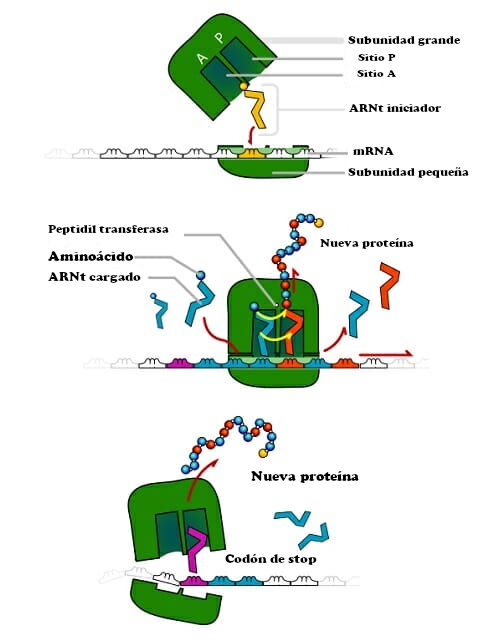Definition of Anticodon
Anticodons are nucleotide sequences that are complementary to codons. They are found in tRNA and allow the tRNAs to bring the correct amino acid in line with a mRNA during protein production.
During protein production, the amino acids are strung together on a string, like beads on a necklace. It is important that the right amino acids are used in the right places, because amino acids have different properties. Putting the wrong one in the wrong place can make a protein useless or even dangerous to the cell.
This graphic shows a growing protein chain. Towards the bottom left, you can see the tRNAs carrying amino acids entering the ribosomal complex. If all goes well, only tRNAs with the correct anticodons will successfully bind to the exposed mRNA, so only the correct amino acids will be added:

tRNAs are responsible for bringing the correct amino acids to be added to the protein, according to the instructions of the mRNA. Their anticodons, which bind to the mRNA codons, allow them to perform this function.
Function of anticodons
The function of anticodons is to assemble the correct amino acids to create a protein, according to the instructions contained in the mRNA.
Each tRNA carries an amino acid and has an anticodon. When the anticodon is successfully paired with an mRNA codon, the cellular machinery knows that the correct amino acid is in place to be added to the growing protein.
Anticodons are necessary to complete the process of converting the information stored in the mRNA to the correct amino acid. DNA into functional proteins that a cell can use to carry out its vital functions.
How anticodons work
When information genetics is converted into a protein, the sequence of events is as follows:
- The genetic information in the cell’s genome is transcribed into mobile pieces of RNA using base-pairing rules. Each nucleotide has only one other nucleotide paired with it.
By pairing the correct RNA nucleotide with every DNA nucleotide, the RNA polymerase creates a strand of RNA that contains all the correct information to make the protein.
This “messenger RNA”, or “mRNA”, then travels to an ribosomethe site of protein production. - In the ribosome, the rules of base pairing are used again to ensure correct information transfer. Each three-nucleotide “codon” in the mRNA is paired with an “anticodon” containing the complementary bases.
The “transfer RNAs” or “tRNAs” that chain proteins together each have an anticodon that corresponds to an mRNA codon and a bound amino acid.
When the correct tRNA encounters the mRNA, its amino acid is added to the growing protein chain.
Enzymes catalyse the binding of amino acids to each other, as tRNA anticodons bind to the correct mRNA codon.
When the tRNA amino acid has been added to the protein chain, the tRNA leaves to pick up a new amino acid and carry it to a new mRNA.
Interestingly, this means that the tRNA anticodon has the RNA version of the same nucleotide sequence of the gene original.
Remember: the gene was transcribed using complementary nucleotides to produce RNA, which then had to be joined with complementary tRNA codons.
RNA base-pairing rules
Each RNA nucleotide can only be joined by RNA base pairing. hydrogen bonding to another nucleotide. By attaching the correct nucleotides, DNA and RNA successfully transfer and use the information.
The four bases of RNA are adenine, cytosine, guanine and uracil. These bases are often named only by their first letter, to make it easier to show sequences of many bases. The base pairing rules for RNA are:
A – U
C – G
G – C
U – A
Simply put, in RNA, A nucleotides always bind with U nucleotides and C nucleotides always bind with G nucleotides.
Differences between RNA and DNA
It is noteworthy that in DNA, the “Uracil” base is a slightly different base called ” Thymine “. In DNA, the A and T pair. Adenine RNA will also pair with the thymine of DNA, and adenine DNA will pair with the uracil of RNA.
The difference between uracil and thymine is that thymine has an extra methyl group, which makes it more stable than uracil.
DNA is thought to use thymine instead of uracil because, as the “master blueprints” of the cell, the information stored in DNA must remain stable over a long period of time. RNAs are just copies of DNA made for specific purposes, and the cell uses them only for a short period of time before they are discarded.
- Amino acid: the building blocks of proteins. Different amino acids have different properties, which allow cells to build proteins to perform many different functions by putting together the right combinations of amino acids.
- Codon: a sequence of three nucleotides in one molecule mRNA molecule encoding a particular amino acid. Most amino acids have more than one codon coding for them, although methionine has only one.
- DNA: a substance used to store the permanent operating instructions of a cell. The information stored in DNA is stable and can be copied to create new daughter cell blueprints using nucleotide base pairing rules.
Discover more terms in our scientific dictionary.
